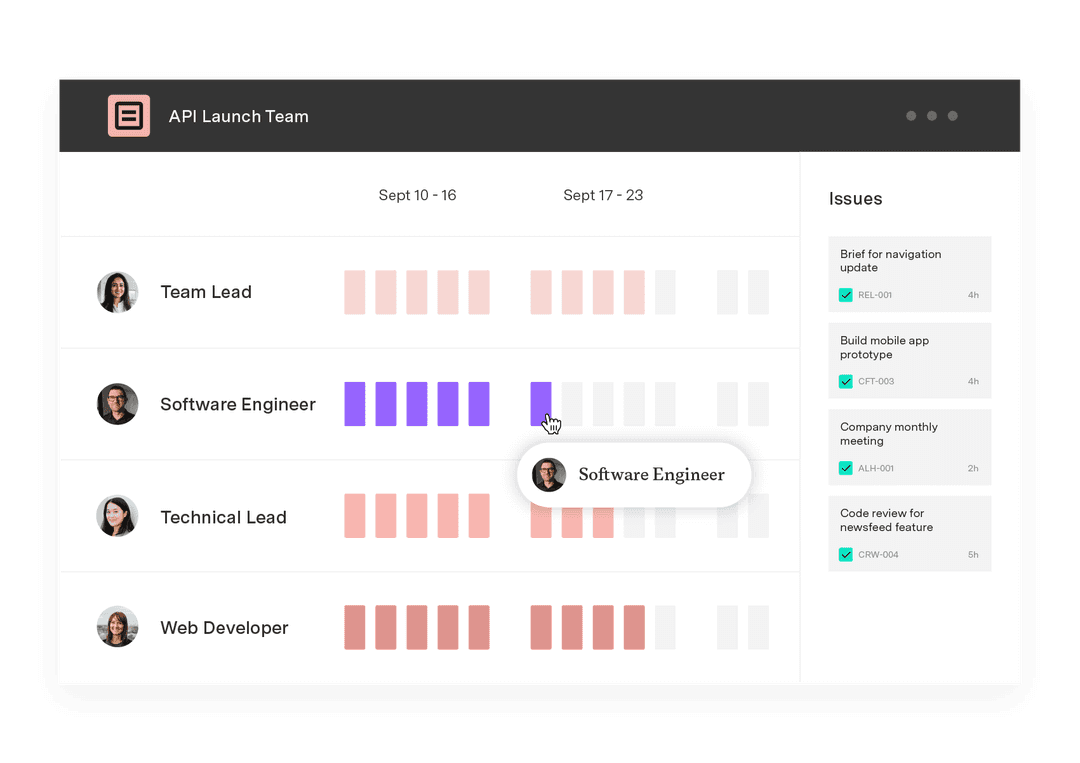Go-to-market strategy: Launch products successfully
Tempo Team
Every time you launch a new product, you learn what worked and what didn’t. And if you don’t use those findings to inform future processes, you’re missing out.
Put learnings, pitfalls, and new ideas into a go-to-market (GTM) strategy. Well-crafted GTM strategies let you launch products with consistent, repeatable success. They identify your target market, define your unique value proposition (UVP), and align sales and marketing tactics.
A purposeful market strategy accounts for every detail, from detailed competitor research to data-driven resource planning. This minimizes risks and helps your team introduce new products confidently.
Discover the ins and outs of a reliable GTM strategy, including the top benefits and the steps to create your own.
What is a go-to-market strategy?
A GTM strategy is a structured plan for launching a new product or business. It helps you define your place in the market and the problem you solve to determine the most effective release plan.
A product launch strategy examines crucial details, including your primary competition, customer needs, and ideal pricing scheme. With this information, you avoid creating a plan that doesn’t fit your product. Say a gym is launching a new yoga studio – a GTM plan helps them consider their new target audience, who may be more interested in stress relief and wellness than average gym-goers.
When do you need a go-to-market strategy?
You need a GTM strategy every time you release a product or service, whether or not you’re launching into an established market. Even if it seems repetitive, walking through a release strategy makes sure you consider every angle and don’t overlook any details.
Here are a few scenarios where you need a GTM plan and why:
Launching a new product in an existing market: Launch strategies aligns a brand-new offering with your current, loyal customers. For example, a makeup brand releasing skincare products may need to angle them as luxurious and anti-aging. A GTM strategy helps it achieve that.
Introducing an existing product to a new market: Some brands need to identify new customer needs and how a current product solves them, like considering a sales tool’s value to marketers instead of salespeople.
Releasing a new product in a new market: This strategy examines every angle, including competition, audience, and ideal UVP. For instance, an app creator needs to identify its software’s main sale points and ideal customer.
Repositioning an existing product: A GTM strategy helps you pivot a product and alter audience perception without damaging your customer base. Say an energy drink company wants to expand beyond its gamer reputation. This plan carefully widens demographics while maintaining performance and sales.
Steps to build a go-to-market strategy in 7 steps
A GTM strategy framework gives you a solid starting point and covers the essentials, like choosing a UVP and target audience. From here, you can customize and polish your plan until it’s perfect.
Here’s a GTM plan template to adjust to your needs:
1. Define your target audience
First, identify your ideal market. This tells you who’s buying your product, their main pain points, and why they need your services. Most teams create ideal customer personas (ICP) to organize these key details and keep them at hand.
The target audience informs the rest of the launch plan, from price points to specific marketing tactics. For example, a B2B GTM strategy targets companies rather than individuals, meaning it focuses on value and return on investment (ROI). B2C strategies instead need to make an emotional connection.
2. Research the competition and clarify your UVP
Next, review competition and demand. Research similar products and services and examine their strengths, weaknesses, and target audience to see where your offerings stand. This lets you define a UVP more clearly and avoid an oversaturated market.
Say you’re launching a meal delivery service and your competitor research turns up dozens of similar services. Use this information to aim your project toward vegans and vegetarians to narrow your audience and meet niche demand.
3. Choose your marketing and sales channels
Determine which marketing channels to use and when. This is the content and advertising that will generate demand, increase excitement, and direct customers down your marketing funnel. Research various types and choose methods that fit your product and audience. For example, SEO articles and newsletters are excellent for a B2B product.
Conduct a similar process to choose the best sales model. B2C offerings, like retail stores, use a self-service method, where customers find and purchase your goods on their own. But B2B services use inside sales, where representatives nurture prospects and lead them to conversion.
4. Create your pricing strategy
Examine your product and set a competitive, suitable price. Find a strong middle point – if the cost is too high you risk reduced sales, but if it’s too low you compromise your revenue. Consider production costs, competitor prices, and how much your ICP is willing to pay for a service like yours.
You also need to choose your pricing model. A transactional model involves one-time purchases and is most common for B2C businesses, while subscriptions offer access to a service for an ongoing fee and are popular for B2B companies.
5. Align product, marketing, and sales teams
Keep product, marketing, and sales teams connected and focused on shared goals. They all play a critical role in product launch, and the more closely they work together, the better. For example, a product team should help marketing shape the ICP for a tailored buyer persona, and marketing should supply sales enablement assets for more relevant prospecting.
Establish a unified communication and feedback channel and encourage team members to use it. Say a sales rep repeatedly hears prospects mention a certain feature – they can pass the tip on to the product and marketing teams to help them emphasize it in their messaging.
6. Build a launch plan and define goals
Determine clear goals, a timeline, and benchmarks to measure the success of your GTM strategy. This gives visibility into your launch, telling you what works and what needs improvement so you can boost performance in current and future initiatives.
For example, a B2B marketing team may set a goal to generate $50,000 in new product revenue in three months. They can compare their progress and timeline against this objective to measure the strategy’s success.
7. Gather feedback and iterate post-launch
Continuously adjust your GTM strategy. Monitor key performance indicators (KPIs), track internal metrics (like cost-per-acquisition), and gather customer opinions via social media and surveys to gain insight into pricing, marketing success, and product quality.
A strong strategy should be dynamic. Listen to feedback, make adjustments, and keep an eye on metrics to track the impact of your changes.
Go-to-market strategy benefits
A GTM plan gives you the control to launch products deliberately and strategically. Here are the advantages of creating a thorough strategy:
Faster product launches: Identifying elements, like your target audience and ideal marketing channels, in advance reduces typical launch barriers. This enhances product velocity and lets you enjoy a smoother process.
Reduced risk: GTM strategies highlight potential issues before they crop up, like oversaturated markets or low demand. This lets you eliminate predictable problems and prepare for anything unavoidable.
Stronger customer alignment: Researching your audience leads to a better product-market fit. Carefully customize your pricing and messaging for a more powerful launch, higher revenue, and improved customer satisfaction over time.
Efficient resource planning: Focusing on the highest impact marketing and sales channels means you get the most out of your resources. Pour time and money into valuable strategies and reduce waste.
Supporting go-to-market execution with Tempo
GTM strategies help you launch products effectively, whether it’s a new service or a unique repositioning. This business framework provides direction and clarity, encouraging clear ICPs and team visibility.
Tempo takes alignment to the next level. Capacity Planner lets you visualize multiple teams and shared resources to make informed, cross-department decisions. You can also track GTM goals with Timesheets. Monitor time spent on each activity, focus efforts on high-value tasks, and optimize your project’s productivity.
Boost your next marketing plan with Tempo. Get started today.













































